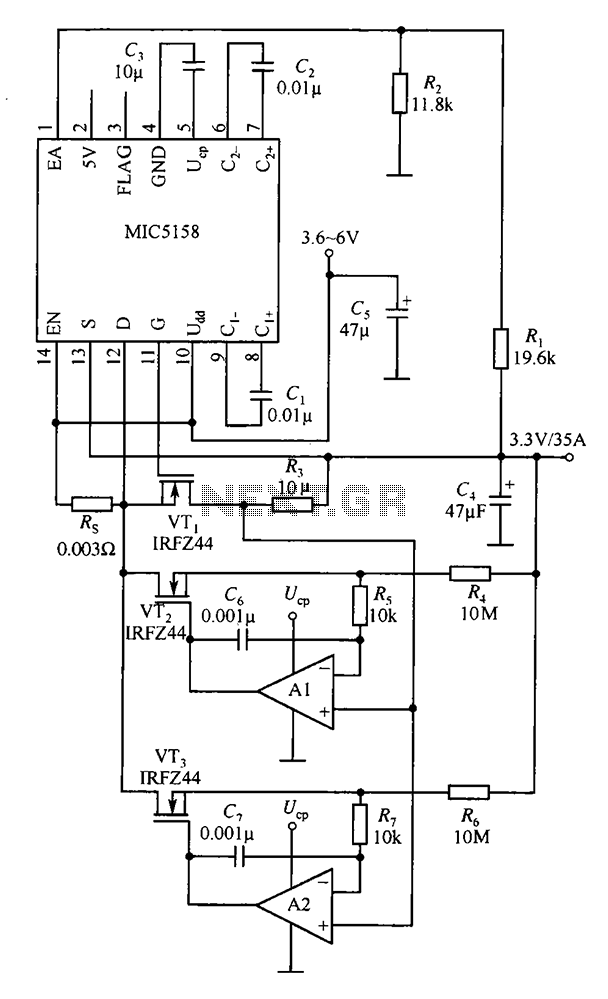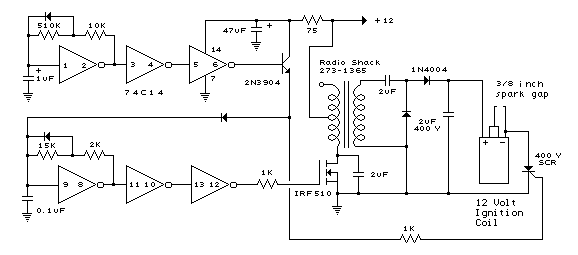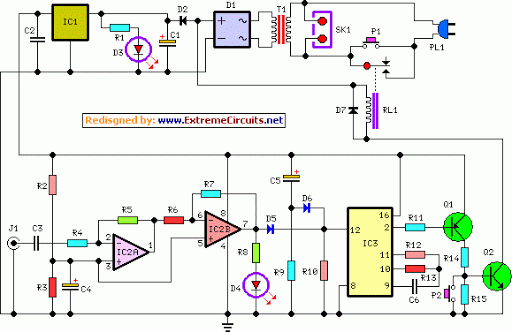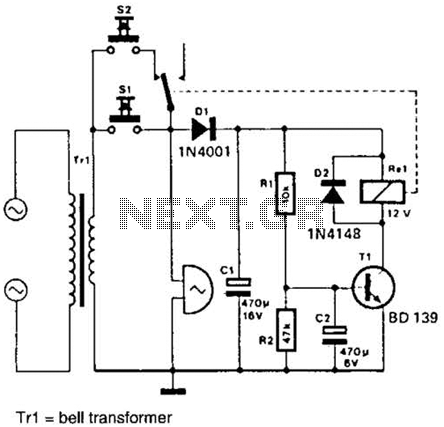
circuit transistor tester
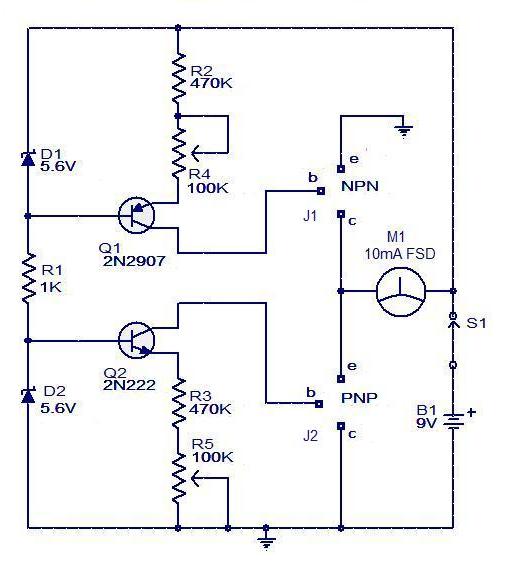
The circuit for a transistor tester is a relatively simple device. The transistor tester circuit illustrated below can be utilized to measure and identify the pins of a transistor, as well as determine its condition. Furthermore, this circuit can also identify the type of transistors being measured. The transistor tester circuit consists of two transistors, an ammeter, and several supporting components. It can be powered using a DC voltage source, such as a 9V battery or power supply. Terminals J1 and J2 on the transistor tester circuit are designated for connecting the transistor under test. A detailed schematic of the transistor tester circuit is provided in the following figure. The bias control circuit regulates the base bias of the transistor being tested. For testing an NPN transistor, the base bias is controlled by resistor R4, transistor Q1, and diode D1. Conversely, for testing a PNP transistor, the base bias is managed by Q2, R5, and D2. The transistor base bias control circuit essentially sets a specific voltage and current to the base of the transistor being tested. The meter in the transistor tester circuit is an ammeter that displays the collector current (Ic) for NPN transistors and the emitter current for PNP transistors during the test.
The transistor tester circuit is designed to facilitate the evaluation of both NPN and PNP transistors, providing a user-friendly interface for identifying transistor functionality. Upon connecting the transistor to terminals J1 and J2, the circuit automatically determines the type of transistor based on the biasing configuration. The inclusion of the ammeter allows for real-time monitoring of the collector or emitter current, providing valuable feedback on the transistor's operational state.
The bias control circuit is critical for accurately measuring the transistor's characteristics. For NPN transistors, when the base is biased through R4, the circuit allows current to flow from the collector to the emitter, enabling the ammeter to display the corresponding collector current. In contrast, the PNP transistor configuration requires the bias to be applied through Q2, R5, and D2, allowing for the measurement of the emitter current.
The choice of a 9V power source is optimal for ensuring sufficient voltage levels for testing various transistor types while maintaining safety and ease of use. The supporting components, including resistors and diodes, are selected to provide stability and protection against potential overcurrent situations during testing.
Overall, this transistor tester circuit serves as an essential tool for electronics engineers and hobbyists alike, allowing for quick and effective testing of transistor functionality and characteristics. It simplifies the process of identifying faulty components and aids in the design and troubleshooting of electronic circuits.Circuit transistor tester is a fairly simple circuit tester. Transistor tester circuit shown below can be used to measure and know the pins and determine the condition of the transistor. In addition this circuit transistor tester can also find out what kind of transistors are measured. Transistor tester circuit is built with 2 transistor, an amper e meter, and some supporting components. Transitor Circuit tester can be operated using a DC voltage source from a 9V battery or power supply. J1 and J2 on the circuit transistor tester is a terminal for the transistor to be on the test. Transistor tester circuit in detail can be seen in the following figure. Bias control transistor serves to regulate the transistor base bias in the test. To test the NPN transistor base bias controlled by R4 Q1 and D1. Then to test the PNP transistor base bias is controlled by Q2 R5 and D2. Transistor base bias control circuit is basically a set amount of voltage and current to the transistor base is tested.
Meter in the circuit transistor tester is an ampere meter to display functioning at the transistor collector current Ic and the current NPN transistor PNP emitter on the on the test. 🔗 External reference
The transistor tester circuit is designed to facilitate the evaluation of both NPN and PNP transistors, providing a user-friendly interface for identifying transistor functionality. Upon connecting the transistor to terminals J1 and J2, the circuit automatically determines the type of transistor based on the biasing configuration. The inclusion of the ammeter allows for real-time monitoring of the collector or emitter current, providing valuable feedback on the transistor's operational state.
The bias control circuit is critical for accurately measuring the transistor's characteristics. For NPN transistors, when the base is biased through R4, the circuit allows current to flow from the collector to the emitter, enabling the ammeter to display the corresponding collector current. In contrast, the PNP transistor configuration requires the bias to be applied through Q2, R5, and D2, allowing for the measurement of the emitter current.
The choice of a 9V power source is optimal for ensuring sufficient voltage levels for testing various transistor types while maintaining safety and ease of use. The supporting components, including resistors and diodes, are selected to provide stability and protection against potential overcurrent situations during testing.
Overall, this transistor tester circuit serves as an essential tool for electronics engineers and hobbyists alike, allowing for quick and effective testing of transistor functionality and characteristics. It simplifies the process of identifying faulty components and aids in the design and troubleshooting of electronic circuits.Circuit transistor tester is a fairly simple circuit tester. Transistor tester circuit shown below can be used to measure and know the pins and determine the condition of the transistor. In addition this circuit transistor tester can also find out what kind of transistors are measured. Transistor tester circuit is built with 2 transistor, an amper e meter, and some supporting components. Transitor Circuit tester can be operated using a DC voltage source from a 9V battery or power supply. J1 and J2 on the circuit transistor tester is a terminal for the transistor to be on the test. Transistor tester circuit in detail can be seen in the following figure. Bias control transistor serves to regulate the transistor base bias in the test. To test the NPN transistor base bias controlled by R4 Q1 and D1. Then to test the PNP transistor base bias is controlled by Q2 R5 and D2. Transistor base bias control circuit is basically a set amount of voltage and current to the transistor base is tested.
Meter in the circuit transistor tester is an ampere meter to display functioning at the transistor collector current Ic and the current NPN transistor PNP emitter on the on the test. 🔗 External reference
Warning: include(partials/cookie-banner.php): Failed to open stream: Permission denied in /var/www/html/nextgr/view-circuit.php on line 713
Warning: include(): Failed opening 'partials/cookie-banner.php' for inclusion (include_path='.:/usr/share/php') in /var/www/html/nextgr/view-circuit.php on line 713
